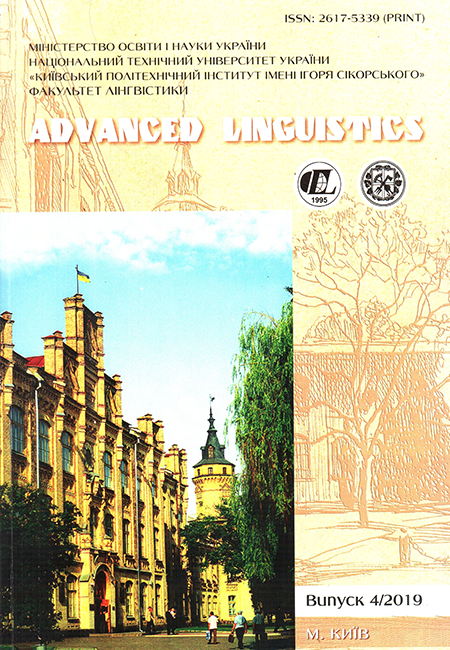INTERCULTURAL COMMUNICATION COMPETENCE IN SPECIALIZED LANGUAGES AND CONTEXTS: RESEARCH PROSPECTS AND POSSIBILITIES.
DOI:
https://doi.org/10.20535/2617-5339.2019.4.181340Ключові слова:
English as a lingua franca, specialized languages, EHEA, intercultural communication, ICC assessmentАнотація
Recent advances in communication technologies, globalization, internet 2.0, mobile communication and social networks, among many other factors, have led to a growth of possibilities of communication between people of different languages and cultures never seen before in the history of the world (Fantini, 2009).
However recent language research highlights the fact that knowledge of the language alone does not guarantee successful communication in international contexts: cultural diversity, intercultural communication competence, cultural intelligence, intercultural sensitivity and intercultural awareness place an emphasis on the intercultural dimension of foreign language education (Zaharna, 2009; Committee for Economic Development, 2006)
In sum, language training in professional settings needs to be customized according to the academic context, social demands and professional profiles of individuals. Existing intercultural communication competence assessment instruments seem to focus on generic needs of learners, based on a generic learning context, and measure the individual’s ability to communicate in a foreign language across cultural boundaries (Byram, 1997: p. 7; Fritz, Möllenberg & Chen 2002: p.166), but at the same time, seem to pay attention to the variable of a specialized context biased by cultural constrains. It seems that universal ICC assessment models are failing to meet actual requirements and training efforts are not aligned with teaching objectives.
Upon identifying the basic dimensions of intercultural communication such as knowledge, attitude and behaviour, this study proposes a revision of different specialized communication settings and ICC instruments from the perspective of professional communication and then review existing research lines to, finally, propose research opportunities from the point of view of specialized languages and contexts.
Посилання
Arasaratnam, L. A., & Doerfel, M. L. (2005). Intercultural communication competence: Identifying key components from multicultural perspectives. International Journal of Intercultural Relations, 29, 137-163. http:// dx.doi.org/10.1016/j.ijintrel.2004.04.001
Byram, M., Morgan, C. et al (1994). Teaching and Learning Language and Culture. Clevedon: Multilingual Matters.
Byram, M. (1997). Teaching and Assessing Intercultural Communicative Competence. Clevedon: Multilingual Matters.
Cabré, M.T. (1993). La terminología. Teoría, metodología, aplicaciones. Barcelona: Editorial Antártida/Empúries.
Candel-Mora, M.A. (2015). Attitudes towards Intercultural Communicative Competence of English for Specific Purposes Students. Procedia - Social and Behavioral Sciences, 178, 26–31. http://dx.doi.org/10.1016/j. sbspro.2015.03.141
Committee for Economic Development Research and Policy Committee. (2006). Education for global leadership: The importance of international studies and foreign language education for U.S. economic and national security. Washington, DC: Committee for Economic Development.
Deardorff, D.K. (2006). Identification and Assessment of Intercultural Competence as a Student Outcome of Internationalization. Journal of Studies in International Education, 10, 241-266. http://dx.doi. org/10.1177/1028315306287002ELIA 15, 2015, pp. 93-107 106 Benchmarking intercultural communication competence... DOI: http://dx.doi.org/10.12795/elia.2015.i15.05
Deardorff, D. K. (2009). Implementing Intercultural Competence Assessment. In D. K. Deardorff (Ed.), The SAGE Handbook of Intercultural Competence (pp. 477-491). Thousand Oaks, CA: Sage.
Fantini, A. (2009). Assessing Intercultural Competence: Issues and Tools. In D. K. Deardorff (Ed.), The SAGE Handbook of Intercultural Competence (pp. 456-476). Thousand Oaks: SAGE Publications.
Fritz, W., Möllenberg, A. and Chen, G. (2002). Measuring Intercultural Sensitivity in Different Cultural Contexts. Intercultural Communication Studies, 11, 2.
Hoffmann, L. (1998). Llenguatges d’especialitat. Barcelona: IULA, Universidad Pompeu Fabra.
Intercultural Training and Assessment Tools. (2015). Portland: Intercultural Communication Institute. Retrieved on 01-03-2019 from http://www. intercultural.org/tools.php.
Leuven and Louvain-la-Neuve Communiqué (2009). The Bologna Process 2020: The European Higher Education Area in the new decade. Commmuniqué of the Conference of European Ministers Responsible for Higher Education. Belgium. Retrieved on 05-04-2015 from http://www.ehea. info/Uploads/Declarations/Leuven_Louvain-la- Neuve_Communique_ April_2009.pdf.
Planken, B., van Hoofl, A. and Korzilius, H. (2004). Promoting Intercultural communicative competence through foreign language courses. Business Communication Quarterly, Vol. 67 (3). 308-315.
Shuang, L. (2012). Rethinking intercultural competence: Global and local nexus, Journal of Multicultural Discourses, 7, 269-275. http://dx.doi.org/10.10 80/17447143.2012.693085
Spitzberg, B. H., & Changnon, G. (2009). Conceptualizing intercultural competence. In D. K. Deardorff (Ed.), The Sage Handbook of Intercultural Competence (pp. 2-52). Thousand Oaks: SAGE Publications.
Zaharna R. S. 2009. An Associative Approach to Intercultural Communication Competence in the Arab World. In D. K. Deardorff (Ed.), The SAGE Handbook of Intercultural Competence (pp. 179-195). Thousand Oaks: SAGE Publications.
##submission.downloads##
Опубліковано
Номер
Розділ
Ліцензія
Наше видання використовує положення про авторські права CREATIVE COMMONS для журналів відкритого доступу.
Автори, які публікуються у цьому журналі, погоджуються з наступними умовами:
1. Автори залишають за собою право на авторство своєї роботи та передають журналу право першої публікації цієї роботи на умовах ліцензії Creative Commons Attribution License, котра дозволяє іншим особам вільно розповсюджувати опубліковану роботу з обов'язковим посиланням на авторів оригінальної роботи та першу публікацію роботи у цьому журналі.
2. Автори мають право укладати самостійні додаткові угоди щодо неексклюзивного розповсюдження роботи у тому вигляді, в якому вона була опублікована цим журналом (наприклад, розміщувати роботу в електронному сховищі установи або публікувати у складі монографії), за умови збереження посилання на першу публікацію роботи у цьому журналі.

